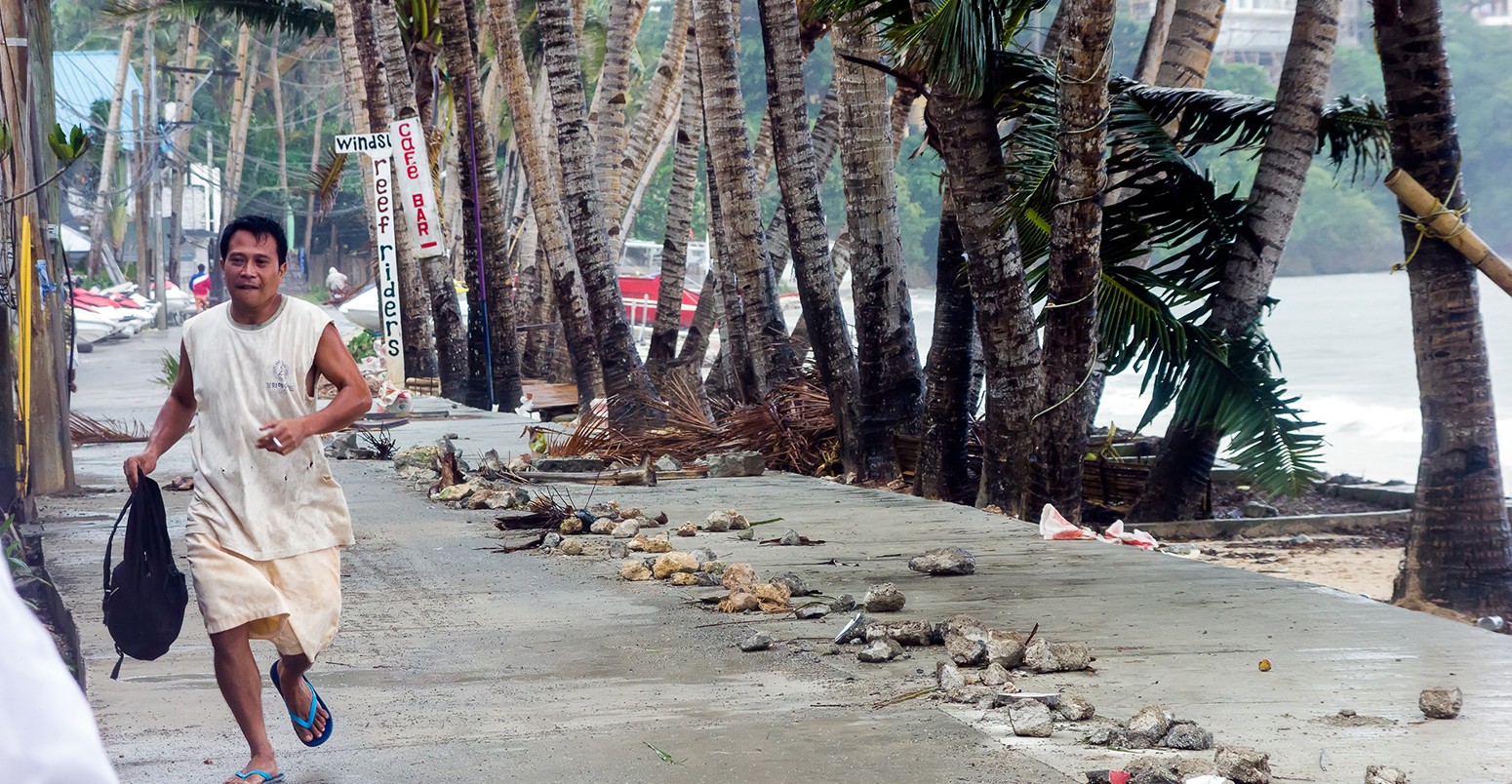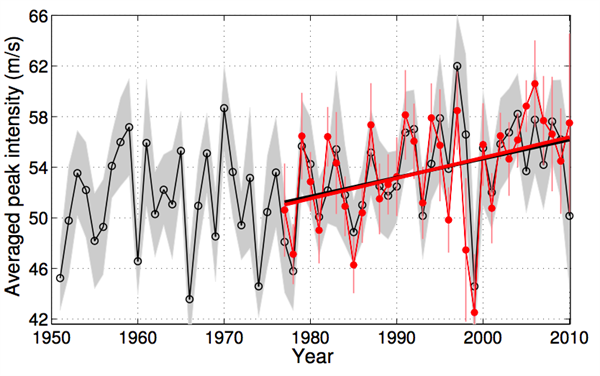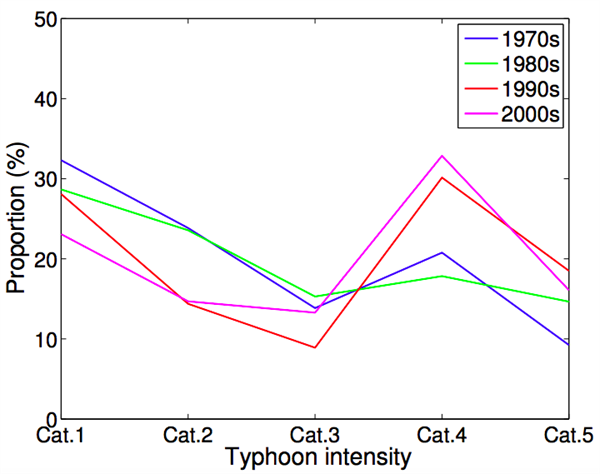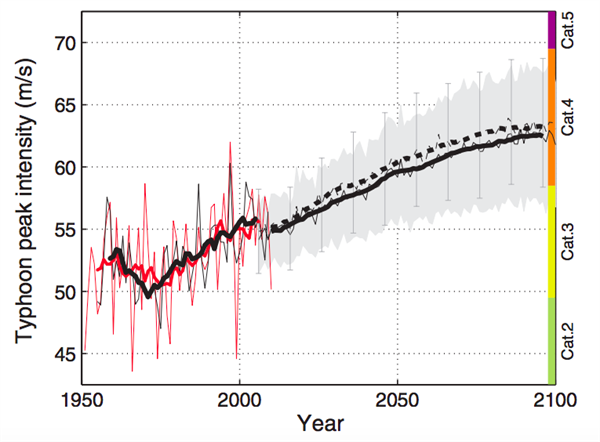
Warming oceans could mean typhoons are 14% stronger by 2100, study says
Robert McSweeney
05.29.15Robert McSweeney
29.05.2015 | 7:00pmOn 7 November 2013, one of the strongest typhoons in human history hit the Philippines. With gusts up to 171 miles per hour (mph), Typhoon Haiyan tore through the many thousands of islands, killing over 6,200 people and affecting 14 million more.
Every year, these giant storms cause damage and destruction across southeast Asia. Now, a new study suggests that even under a moderate temperature rise, warming oceans could fuel more intense typhoons in the future.
Peak wind speeds
Large tropical storms, sometimes referred to collectively as tropical cyclones, have different names in different parts of the world. In countries around the North Atlantic such as the UK, for example, we call them hurricanes. In the northwest Pacific Ocean, they are known as typhoons.
Typhoon strength is measured by wind speed. Anything over 74 miles per hour (mph) is classified as category one, while only the strongest events with wind speeds over 156 mph reach category five. In the new study, published in Science Advances, researchers assessed how climate change could affect the maximum wind speed of typhoons.
Using typhoon wind speed records for the past 60 years, the researchers looked at how the strength of typhoons has changed. You can see the rise in peak wind speeds from the red line in the graph below. Today, typhoon wind speeds are around 10% stronger than they were in the 1970s.

Change in the annual average peak wind speed of typhoons. Thin lines show observed data, and the thick lines show linear trends between 1977 and 2010. Source: Mei. et al. (2015) Supplementary information.
The destruction caused by a typhoon doesn’t just rise in line with wind speed. A 10% rise translates to a 33% increase in destructiveness, the researchers say.
We’re also seeing an increasing number of typhoons reaching the highest intensity categories, the study says. In the graph below, you can see there’s a higher proportion of category four and five typhoons in the 1990s (red line) and 2000s (pink) compared to during the 1970s (blue) and 1980s (green).

Changes in proportions of typhoons of different intensity, from category one (weakest) to five (strongest). Source: Mei. et al. (2015) Supplementary information.
Ocean temperatures
The researchers analysed how typhoon strength in the past varied in response to changing conditions in the oceans and the atmosphere. They concentrated on an area of the northwest Pacific Ocean, just to the south of Japan and to the west of Taiwan and the Philippines.
Scientists have known for a while that the strength of tropical cyclones is linked to the heat content of the oceans, as Mei explains:
A warmer sea surface generally provides more energy for storm development and thus favours higher intensification rates and more intense typhoons.
Their results suggest ocean surface temperatures in this region are the most significant factor affecting maximum typhoon wind speeds from one year to the next, lead author Dr Wei Mei, from the University of California, tells Carbon Brief:
How strongly and quickly a cyclone can grow depends on two oceanic factors: pre-storm sea surface temperature and the difference in temperature between the surface and subsurface.
The researchers then built a statistical model to project how typhoon peak wind speeds are likely to change as the oceans continue to warm in the future.
Category change
Under a moderate emissions scenario ( RCP4.5), where greenhouse gas concentrations in the atmosphere stabilise around the 2050s, ocean temperatures in the study area would be around 1.4C warmer than a baseline period of the 2000s.
It’s worth remembering that the latest research shows current emissions tracking the highest emissions scenario of those used by the Intergovernmental Panel on Climate Change (IPCC) scenarios, so temperatures are likely to be even higher.
Based on RCP4.5, the model results suggest warmer conditions are likely to produce typhoons with peak wind speeds around 14% higher by 2100. As the graph below shows, this increase would push the average typhoon from a category three to a category four.

Observed and projected typhoon peak wind speeds. Graph shows observed (thin red line), projected (thin black line) changes, with their corresponding 9-year rolling averages shown as the bold lines. Source: Mei. et al. (2015).
The projected increase in wind speed is at the high end of recent estimates by other scientists, says Prof Kerry Emanuel, professor of atmospheric sciences at Massachusetts Institute of Technology, who wasn’t involved in the study. Nevertheless, Emanuel tells Carbon Brief the study represents a valuable contribution:
This is exciting and well executed research which will no doubt influence future work on the relationship between tropical cyclones and climate.
Warming climate
Increasingly intense typhoons, as with other types of tropical cyclones, fits in with what scientists expect from a warming climate.
For example, the latest report from the IPCC says while there could be a decrease or no change in the number of tropical cyclones occurring globally through the 21st century, they are likely to be stronger when they do strike.
Prof Kevin Trenberth from the US National Center for Atmospheric Research, who also wasn’t involved in the study, says the results seem “somewhat reasonable”, but raises some concerns about data quality. He tells Carbon Brief:
The main typhoon dataset used is known to include effects from improved and changing technology. The data are especially poor prior to 1970, when the satellite era began and also the ocean heat content data are poor then and prior to then.
The researchers did test the pre-satellite data by comparing their results with model runs where it wasn’t included, Wie says:
The results generally do not change, and thus inclusion of typhoon data before the satellite era does not affect our main conclusions.
Trenberth also points out that on top of higher wind speeds, there are other ways to measure intensity:
The main effects of climate are expected to be an increase in [typhoon] activity. So this includes intensity, duration, size, number/frequency, etc. The dataset does not include information about size, and the duration at each intensity is only partly dealt with… So most of the important metrics are not dealt with in this study.
So, the impact of rising temperatures on peak wind speed is just one piece of the puzzle of how typhoons could change in the future. But as stronger typhoons pose a bigger threat, it’s another step in trying to understand the risks climate change poses to lives and livelihoods of people across Asia.
Main image: A man runs from the seafront as Super Typhoon Haiyan / Yolanda slams into the east coast sending palm trees, metal and rocks through the air.
Mei, W. et al. (2015) Northwestern Pacific typhoon intensity controlled by changes in ocean temperatures, Science Advances, doi:10.1126/sciadv.1500014

